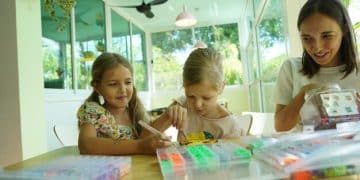Positive discipline techniques for toddlers that really work

Positive discipline techniques for toddlers focus on guiding behavior through clear communication, consistent routines, and emotional support, fostering self-esteem and strong family bonds.
Positive discipline techniques for toddlers can transform parenting by encouraging respectful communication and emotional growth. Have you considered how these methods might improve your parenting journey? Let’s dive into some practical tips that can make a difference.
Understanding positive discipline
Understanding positive discipline is crucial for parents wanting to support their toddlers’ growth. It emphasizes communication and teaching rather than punishment. This approach fosters a nurturing environment where kids can learn from their mistakes and develop emotional intelligence.
What is positive discipline?
Positive discipline is a method that encourages parents to guide their children with respect and understanding. It helps in setting limits and providing support without resorting to harsh punishment.
Key principles of positive discipline
- Respectful communication: Talk to your child in a way that conveys understanding.
- Encouragement: Focus on what your child does well, celebrating their efforts.
- Natural consequences: Allow children to experience outcomes of their choices safely.
- Consistency: Be steady in your approach to build trust and understanding.
When using positive discipline, it’s important to remember that children thrive on clear expectations. This approach helps them understand the importance of limits and boundaries without fear. For example, instead of yelling or punishing, explain why certain behaviors are unacceptable, and offer alternative choices.
Connecting emotions to actions can deepen their understanding. For instance, if a toddler hits another child, calmly explaining that hitting hurts feelings can resonate more than simply saying “no.” Use empathetic language and invite them to express their feelings to others. By recognizing emotions, children learn to communicate better.
Benefits of adopting positive discipline
Adopting positive discipline techniques can increase a child’s self-esteem. When children feel understood, they are more likely to take risks and learn.
- Improved behavior: Children can learn acceptable behavior through guidance.
- Stronger bonds: Positive discipline enhances the parent-child relationship.
- Enhanced problem-solving skills: Children learn to resolve conflicts independently.
Integrating positive discipline into daily routines takes practice but leads to lasting changes. Your toddler will not only learn the rules but will also learn to navigate emotions and relationships, setting the stage for a harmonious family life.
Effective strategies for implementing techniques

Implementing effective strategies for positive discipline can transform your parenting approach. By being intentional, you can create a supportive environment for your toddler to thrive. Start by setting clear rules that your child can understand. This helps them know what is expected, which can reduce confusion and frustration.
Creating a structured environment
A structured environment can significantly boost your child’s ability to follow rules. Consistency is key, so maintain a routine that your child can rely on.
Key strategies for success
- Model behavior: Children learn by watching. Demonstrate how to express feelings and handle conflicts.
- Use positive language: Frame instructions positively. Instead of saying “Don’t run,” try “Please walk steadily.” This approach encourages good behavior.
- Offer choices: Giving your toddler choices empowers them. For example, ask, “Would you like to play with blocks or read a book?” This enhances their decision-making skills.
- Stay calm: When addressing behavior issues, keep your tone and demeanor calm. This models emotional regulation for your child.
Incorporating these strategies requires practice. It’s normal to face challenges along the way. Remember that patience is essential. Celebrate the small victories to keep both you and your child motivated. For example, if your toddler successfully follows a rule, acknowledge their effort with praise. Saying, “I’m proud of you for sharing your toys!” reinforces positive behavior.
Understanding your toddler’s developmental stage is also crucial. Toddlers are naturally curious and learning about boundaries. Respond to misbehavior with guidance, not punishment. Instead of scolding, try explaining why a behavior is inappropriate. This not only teaches the concept of limits but also helps them learn about empathy.
Incorporating play and learning
Use playtime to reinforce positive discipline techniques. Engage in interactive games that require turn-taking and sharing. This reinforces social skills while making learning enjoyable.
- Role-playing: Create scenarios where your child can practice good behavior in a fun way.
- Storytelling: Read stories that highlight characters demonstrating positive behavior.
- Games: Use board games to teach patience and following rules.
By strategically implementing these techniques, you create a reinforcing cycle of respect and communication within your home. This approach leads to a more balanced relationship between you and your child.
Recognizing the benefits of positive discipline
Recognizing the benefits of positive discipline is vital for effective parenting. This approach not only helps in managing behavior but also fosters a strong parent-child relationship. Through positive discipline, children learn valuable skills such as self-control, empathy, and problem-solving.
Emotional development
One key benefit is the enhancement of emotional development. When parents use positive discipline, children feel valued and understood. This supportive environment encourages them to express their feelings openly, which is essential for emotional growth.
Building self-esteem
Another important aspect is the boost in self-esteem. Children who experience positive discipline tend to have higher self-confidence because their achievements are recognized and celebrated. Instead of focusing solely on punishment, this method highlights positive behavior, leading to a stronger sense of self-worth.
- Encouragement: Praising effort helps children feel accomplished.
- Independence: Allowing children to make choices fosters autonomy.
- Support: Emotional support builds trust and security.
Moreover, positive discipline helps children understand the consequences of their actions in a safe and supportive manner. When children learn from their mistakes without fear of harsh punishment, they develop resilience and the ability to bounce back from setbacks.
Improving behavior
Another benefit is improved behavior. Consistent use of positive discipline encourages children to follow rules and understand boundaries. When they know what is expected of them and receive positive reinforcement for good behavior, they are more likely to repeat those behaviors.
- Clear expectations: Setting clear rules helps children understand limits.
- Problem-solving skills: Children learn to address conflicts constructively.
- Social skills: Positive interactions teach effective communication.
Positive discipline also leads to stronger family bonds. When parents and children communicate openly and respectfully, it creates a nurturing atmosphere. This enhances family relationships, making it easier to navigate challenges together.
Incorporating positive discipline strategies into daily life not only helps in raising well-adjusted toddlers but also builds a harmonious household where everyone feels respected and valued.
Tips for consistent application at home

Applying consistent techniques for positive discipline at home is essential for effective parenting. Establishing routines and clear expectations helps toddlers understand behavior boundaries. When they know what is expected, it reduces confusion and frustration.
Establishing routines
Creating daily routines provides structure that children thrive on. Routines help children understand what comes next and make them feel safe. This consistency can help reduce tantrums, as children are more aware of what to expect throughout the day.
Communicating clearly
Clear communication is key to consistent application. Always use simple, positive language. Explain rules and routines in easy-to-understand terms. For example, instead of saying “Don’t run inside,” try, “Please walk in the house.” This type of communication encourages better behavior.
- Set clear expectations: Make sure your toddler knows what behaviors are acceptable.
- Use visual aids: Charts or pictures can help illustrate rules.
- Be patient: Remember that learning takes time, and mistakes will happen.
Another important aspect is remaining calm and composed during challenging moments. Consistency in your reactions teaches toddlers that their feelings are valid and helps them learn how to manage emotions. For instance, if your child throws a toy, calmly explain why that behavior is inappropriate and suggest a better way to express their feelings.
Positive reinforcement
Using positive reinforcement can greatly enhance the effectiveness of your discipline techniques. Celebrate good behavior with praise. This type of encouragement motivates children to repeat positive actions. Make it specific; instead of just saying “Good job,” try, “I love how you shared your toys!” This way, your child understands exactly what behavior you appreciate.
- Be consistent with rewards: Create a reward system for positive behaviors.
- Encourage sharing: Praise when your child shares or takes turns with others.
- Practice empathy: Acknowledge your child’s feelings when rules are enforced.
Consistency also involves all caregivers in the child’s life being on the same page. Everyone involved—parents, grandparents, and babysitters—should use similar approaches to discipline. This uniformity helps children feel secure and reinforces what they have learned.
When parents and caregivers demonstrate unity in applying positive discipline techniques, it enhances the learning experience for children. They begin to understand the importance of rules and the reasons behind them, leading to better-behaved toddlers.
FAQ – Positive Discipline Techniques for Toddlers
What are positive discipline techniques?
Positive discipline techniques are approaches that focus on guiding toddlers through understanding and learning appropriate behavior without resorting to punishment.
How can I maintain consistency in discipline at home?
To maintain consistency, establish clear routines, communicate rules in simple terms, and ensure all caregivers use the same approach to discipline.
What are the benefits of using positive discipline?
Benefits include improved emotional development, boosted self-esteem, stronger family bonds, and better behavior in children.
How can I encourage my toddler to express their feelings?
Encourage your toddler to share their feelings by modeling emotional communication and providing a safe space for them to express emotions without fear.





